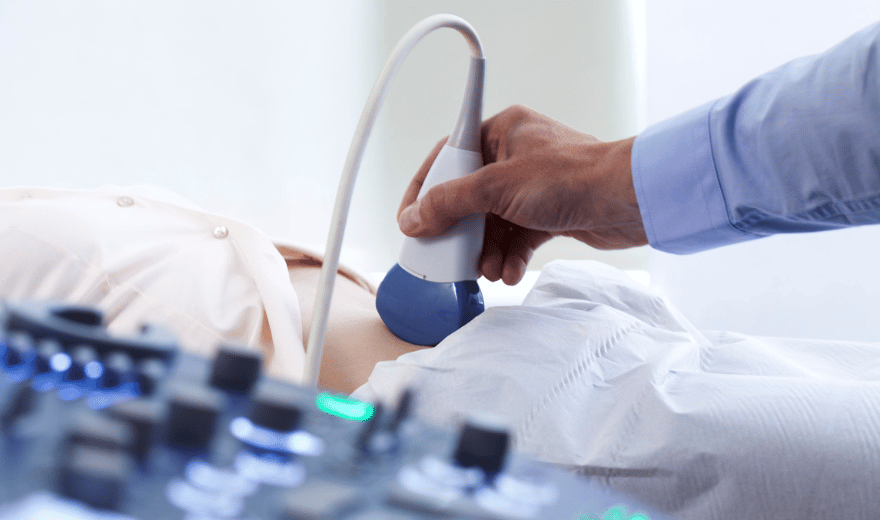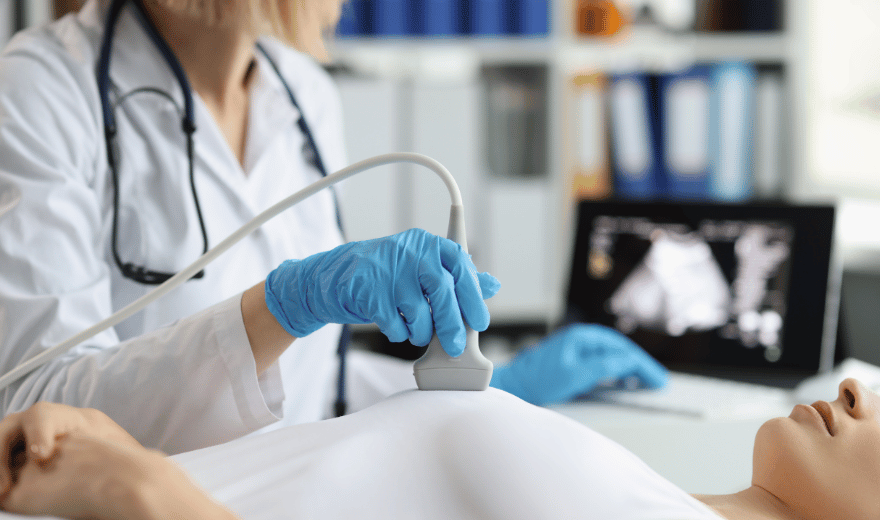
WHAT IS PEDIATRIC ABDOMINAL ULTRASOUND IMAGING?
Ultrasound imaging, also called ultrasound scanning or sonography is a method of obtaining images from inside the human body through the use of high frequency sound waves. The sound waves’ echoes are recorded and displayed as a real-time visual image. No ionizing radiation is involved in ultrasound imaging. Because ultrasound images are captured in real time, they can show movement of internal tissues and organs and enable physicians to see blood flow. This can help to diagnose a variety of conditions and to assess damage caused by illness.
WHAT ARE SOME COMMON USES OF THE PROCEDURE?
In children, an abdominal ultrasound image is a useful way of examining internal organs, including the appendix, liver, gallbladder, spleen, pancreas, intestines, kidneys and bladder. Ultrasound is particularly valuable for evaluating abdominal pain in young children.
Appendicitis is the most common reason for emergency abdominal surgery. It can occur at any age, but is most common in young people ages 11 to 20. Ultrasound imaging is commonly used to help make the diagnosis of appendicitis in children. Ultrasound is fast, accurate and painless, does not require the child to remain still for long periods, and the equipment is less intimidating than the large tunnels of a magnetic resonance imaging (MRI) or computed tomography (CT) scan. In cases when the appendix is not clearly visualized during a clinic-based ultrasound, a hospital-based ultrasound as an outpatient may be needed.
Ultrasound imaging can:
- Help a physician determine the source of abdominal pain, such as stones, abscesses or an inflamed appendix.
- Guide procedures such as needle biopsies, in which needles are used to sample cells from organs for laboratory testing.
- Help identify the cause for enlargement of an abdominal organ.
- Localize abnormal fluid in the abdomen.
HOW SHOULD MY CHILD BE PREPARED FOR THE PROCEDURE?
Your child should be dressed in comfortable, loose-fitting clothing for an ultrasound exam. Other preparation depends on the type of examination. For some scans, you will be instructed to withhold food and drink for as many as 12 hours before your child’s appointment. For others, you may be asked to have your child drink up to six glasses of water two hours prior to the exam and avoid urinating, so that his or her bladder is full when the scan begins. Sedation is rarely needed for ultrasound examinations.
HOW DOES THE PROCEDURE WORK?
Ultrasound imaging is based on the same principles involved in the sonar used by bats, ships at sea and fish detectors. As a controlled sound bounces against objects, its echoing waves can be used to identify how far away the object is, how large it is, and how uniform it is.
The ultrasound transducer functions as both a loudspeaker to create the sounds and a microphone to record them. When the transducer is pressed against the skin, it directs a stream of inaudible, high-frequency sound waves into the body. As the sound waves echo from the body’s fluids and tissues, the sensitive microphone in the transducer records the strength and location of the reflected waves. With Doppler ultrasound the microphone captures and records tiny changes in the sound wave’s pitch and direction. These signature waves are instantly measured and displayed by a computer, which in turn creates a real-time picture on the monitor. Still frames of the moving picture are frozen to capture a series of images.
WHAT WILL MY CHILD EXPERIENCE DURING THE PROCEDURE?
Ultrasound imaging of the abdomen is painless, fast and easy. Your child will lie on his or her back on an examining table. The radiologist or sonographer will spread warm gel on the skin, then press and move the transducer firmly against the body to capture the desired images. There may be varying degrees of discomfort from pressure as the radiologist or sonographer guides the transducer over the abdomen, especially if the child has a full bladder. The examination usually takes less than 30 minutes.
WHAT ARE THE BENEFITS VS. RISKS?
Benefits
- Ultrasound provides real-time imaging, making it a good tool for quick evaluation of potentially emergent conditions such as appendicitis.
- Ultrasound equipment is much less intimidating to young children than the large equipment used in other types of imaging, such as magnetic resonance imaging (MRI) or computed tomography (CT) scans.
- Ultrasound scanning does not require a child to lie perfectly still in order to capture a useful image.
- Ultrasound imaging is a painless, low-cost and non-invasive examination.
- Ultrasound is widely available and easy to use.
- Ultrasound does not expose children to ionizing radiation.
Risks
For standard diagnostic ultrasound there are no known harmful effects to humans.
WHAT DOES THE EQUIPMENT LOOK LIKE?
An ultrasound scanner consists of a console containing a computer and electronics, a video display screen and a transducer that is used to scan the body. The transducer is a small, hand-held device about the size of a bar of soap, attached to the scanner by a cord. The radiologist or sonographer spreads a lubricating gel on the child’s abdomen in the area being examined, and then presses the transducer firmly against the skin to obtain images.
The ultrasound image is immediately visible on a nearby screen that looks much like a computer or television monitor. The radiologist or sonographer watches this screen during an examination; often, the patient is able to see it as well.
HOW IS THE PROCEDURE PERFORMED?
Your child is positioned on an examination table, and then a clear gel is applied to the abdomen to help the transducer make secure contact with the skin. The sound waves produced by the transducer cannot penetrate air, so the gel helps to eliminate air pockets between the transducer and the skin. The sonographer or radiologist presses the transducer firmly against the skin and sweeps it back and forth to image the area of interest.
When the examination is complete, you and your child may be asked to wait while the ultrasound images are reviewed, either on film or on a TV monitor. Often, the sonographer or radiologist is able to review the ultrasound images in real time as they are acquired, and your child can be released immediately.
WHO INTERPRETS THE RESULTS AND HOW DO WE GET THEM?
A radiologist (a physician experienced in ultrasound and other radiology examinations) will analyze the images and send a signed report with his or her interpretation to your pediatrician or primary care physician. You will receive the results from the referring physician who ordered the test.
WHAT ARE THE LIMITATIONS OF PEDIATRIC ABDOMINAL ULTRASOUND IMAGING?
In cases when the appendix is not clearly visualized during a clinic-based ultrasound, a hospital-based ultrasound as an outpatient may be needed.
Ultrasound has difficulty penetrating bone and therefore can only see the outer surface of bony structures and not what lies within. For visualization of bone, other imaging procedures, such as x-ray, computed tomography (CT) or magnetic resonance imaging (MRI), may be selected. Sound waves do not pass through air, and evaluation of the stomach, small intestine and large intestine is limited by gas within these structures.
Preparation
PEDIATRIC ABDOMINAL ULTRASOUND
Ultrasound imaging, also called ultrasound scanning or sonography is a method of obtaining images from inside the human body through the use of high frequency sound waves. The sound waves’ echoes are recorded and displayed as a real-time visual image. No ionizing radiation is involved in ultrasound imaging. Because ultrasound images are captured in real time, they can show movement of internal tissues and organs and enable physicians to see blood flow. This can help to diagnose a variety of conditions and to assess damage caused by illness.
PEDIATRIC ABDOMINAL ULTRASOUND PREPARATION
These instructions are IMPORTANT. Please follow them.
- Your child should be dressed in comfortable, loose-fitting clothing for an ultrasound exam.
- Other preparation depends on the type of examination. For some scans, you will be instructed to withhold food and drink for as many as 12 hours before your child’s appointment. For others, you may be asked to have your child drink up to six glasses of water two hours prior to the exam and avoid urinating, so that his or her bladder is full when the scan begins. Sedation is rarely needed for ultrasound examinations.
continue reading
Related Posts
Cancer screening is testing done on people who may be at risk of getting cancer, but who have no symptoms and generally feel fine.
Ultrasound imaging, also called ultrasound scanning or sonography, involves exposing part of the body to high-frequency sound waves to produce pictures of the inside of the body.
Ultrasound imaging of the scrotum is the primary imaging method used to evaluate disorders of the testicles and surrounding areas.



